狂神说-MyBatis
1、简介#
1.1、概述#
- MyBatis是一款优秀的持久层框架
- 它支持定制化SQL、存储过程以及高级映射。
- MyBatis避免了几乎所有的JDBC代码和手动设置参数以及获取结果集。
- MyBatis 可以使用简单的XML或注解来配置和映射原生类型、接口和Java的POJO (Plain Old JavaObjects,普通老式Java对象)为数据库中的记录。
- MyBatis 本是apache的一个开源项目iBatis,2010年这个项目由apache software foundation迁移到了google code,并且改MyBatis 。
- 2013年11月迁移到Github。
如何获得Mybatis?
- maveb仓库:
<dependency>
<groupId>org.mybatis</groupId>
<artifactId>mybatis</artifactId>
<version>3.5.9</version>
</dependency>
1.2、持久化#
数据持久化
- 持久化就是将程序的数据在持久状态和瞬时状态转化的过程
- 内存:断电即失
- 数据库(jdbc),io文件持久化
- 生活:冷藏
1.3、持久层#
Dao层,Service,Controller
- 完成持久化工作的代码块
- 层界限十分明显
不用Mybatis也可以,技术没有高低之分
2、第一个Mybatis程序#
思路:搭建环境-->导入Mybatis-->编写代码-->测试
2.1、搭建环境#
搭建数据库
CREATE DATABASE `mybatis`;
USE `mybatis`;
CREATE TABLE `user`(
`id` INT(20) NOT NULL,
`name` VARCHAR(30) DEFAULT NULL,
`pwd` VARCHAR(30) DEFAULT NULL,
PRIMARY KEY(`id`)
)ENGINE=INNODB DEFAULT CHARSET=utf8;
INSERT INTO `user`(`id`,`name`,`pwd`) VALUES
(1,'张三','123456'),
(2,'李四','123456'),
(3,'王五','123456')
新建项目
- 新建一个普通的maven项目
- 删除src目录
- 导入maven依赖
<dependencies>
<!-- mysql驱动-->
<dependency>
<groupId>mysql</groupId>
<artifactId>mysql-connector-java</artifactId>
<version>8.0.25</version>
</dependency>
<!-- mybatis-->
<dependency>
<groupId>org.mybatis</groupId>
<artifactId>mybatis</artifactId>
<version>3.5.9</version>
</dependency>
<!-- junit-->
<dependency>
<groupId>junit</groupId>
<artifactId>junit</artifactId>
<version>4.12</version>
<scope>test</scope>
</dependency>
</dependencies>
2.2、创建一个模块#
- 编写mybatis的核心配置文件
<?xml version="1.0" encoding="UTF-8" ?>
<!DOCTYPE configuration
PUBLIC "-//mybatis.org//DTD Config 3.0//EN"
"http://mybatis.org/dtd/mybatis-3-config.dtd">
<!--configuration核心配置文件-->
<!--在这里 & 等价于 &-->
<configuration>
<environments default="development">
<environment id="development">
<transactionManager type="JDBC"/>
<dataSource type="POOLED">
<property name="driver" value="com.mysql.jdbc.Driver"/>
<property name="url" value="jdbc:mysql://localhost:3306/mybatis?useUnicode=true&characterEncoding=utf-8&useSSl=true"/>
<property name="username" value="root"/>
<property name="password" value="123456"/>
</dataSource>
</environment>
</environments>
</configuration>
- 编写mybatis工具类
public class MybatisUtils {
private static SqlSessionFactory sqlSessionFactory;
static {
String resource = "mybatis-config.xml";
InputStream inputStream = null;
try {
//使川Mybatis第一步:获取SqlSessionFactory对象
inputStream = Resources.getResourceAsStream(resource);
sqlSessionFactory = new SqlSessionFactoryBuilder().build(inputStream);
} catch (IOException e) {
e.printStackTrace();
}
}
//既然有了SqLSessionFactory,顾名思义,我们就可以从中获得SqLSession 的实例了。
// SqlSession完全包含了面向数据库执行SQL命令所需的所有方法。
public static SqlSession getSqlSession(){
return sqlSessionFactory.openSession();
}
}
2.3、编写代码#
- 实体类
package com.gao.pojo;
public class User {
private int id;
private String name;
private String pwd;
public User() {
}
public User(int id, String name, String pwd) {
this.id = id;
this.name = name;
this.pwd = pwd;
}
public int getId() {
return id;
}
public void setId(int id) {
this.id = id;
}
public String getName() {
return name;
}
public void setName(String name) {
this.name = name;
}
public String getPwd() {
return pwd;
}
public void setPwd(String pwd) {
this.pwd = pwd;
}
@Override
public String toString() {
return "User{" +
"id=" + id +
", name='" + name + '\'' +
", pwd='" + pwd + '\'' +
'}';
}
}
- Dao类
public interface UserMapper {
List<User> getUserList();
}
- 接口实现类
<?xml version="1.0" encoding="UTF-8" ?>
<!DOCTYPE mapper
PUBLIC "-//mybatis.org//DTD Mapper 3.0//EN"
"http://mybatis.org/dtd/mybatis-3-mapper.dtd">
<!-- namespace=绑定一个对应的Dao/Mapper接口-->
<mapper namespace="com.gao.dao.UserMapper">
<select id="getUserList" resultType="com.gao.pojo.User">
select * from mybatis.user
</select>
</mapper>
2.4、测试#
MapperRegistry是什么
核心配置文件中注册mappers
junit测试
@Test
public void test(){
//获取sqlSession对象
SqlSession sqlSession = MybatisUtils.getSqlSession();
//与配置文件中的SQL建立连接,方法一:getMapper()
UserMapper mapper = sqlSession.getMapper(UserMapper.class);
List<User> userList = mapper.getUserList();
for (User user : userList) {
System.out.println(user);
}
//关闭sqlSession
sqlSession.close();
}
可能会遇到的问题
- 配置文件没有注册
- 绑定的接口不对
- 方法名不对
- Maven导出资源问题
解决方案,在pom.xml中添加:
<! --在bui1d中配置resources,来防止我们资源导出失败的问题-->
<build>
<resources>
<resource>
<directory>src/main/resources</directory>
<includes>
<include>**/*.properties</include>
<include>**/*.xml</include>
</includes>
<filtering>false</filtering>
</resource>
<resource>
<directory>src/main/java</directory>
<includes>
<include>**/*.properties</include>
<include>**/*.xml</include>
</includes>
<filtering>false</filtering>
</resource>
</resources>
</build>
3、CRUD#
1、namespace#
namespace中的包名要和Dao/mapper接口的包名一致
2、select#
选择,查询语句
- id:就是对应的namespace中的方法名
- resultType:sql语句执行的返回值
- parameterType:参数类型
- 编写接口
//根据id查询用户
User getUserById(int i);
- 编写对应的mapper中的sql语句
<select id="getUserById" resultType="com.gao.pojo.User" parameterType="int">
select * from mybatis.user where id = #{id}
</select>
- 测试
@Test
public void getUserById(){
SqlSession sqlSession = MybatisUtils.getSqlSession();
UserMapper mapper = sqlSession.getMapper(UserMapper.class);
User user = mapper.getUserById(3);
System.out.println(user);
sqlSession.close();
3、Insert#
<insert id="addUser" parameterType="com.gao.pojo.User">
insert into mybatis.user(id,name,pwd) values (#{id},#{name},#{pwd})
</insert>
4、update#
<update id="updateUser" parameterType="com.gao.pojo.User">
update mybatis.user set name=#{name},pwd=#{pwd} where id=#{id}
</update>
5、delete#
<delete id="deleteUser" parameterType="int">
delete from mybatis.user where id=#{id}
</delete>
注意点:
- 增删改需要提交事务
sqlSession.commit();
6、万能的Map#
假设,我们的实体类,或者数据库中的表,字段或者参数过多,我们应该考虑使用Map
//万能的map
int addUser2(Map<String,Object> map);
<!--对象中的属性,可以直接取出来 传递map的key-->
<insert id="addUser2" parameterType="map">
insert into user(id,name) values(#{userid},#{userName})
</insert>
@Test
public void addUser2(){
SqlSession sqlSession = MybatisUtils.getSqlSession();
UserMapper mapper = sqlSession.getMapper(UserMapper.class);
Map<String,Object> map = new HashMap<String,Object>();
map.put("userid",5);
map.put("userName","hello");
mapper.addUser2(map);
sqlSession.commit();
sqlSession.close();
}
Map传递参数,直接在SQL中取出key即可
对象传递参数,直接在SQL中取对象的属性即可
只有一个基本类型参数的情况下,可以直接在SQL中取到
多个参数用Map,或者注解
7、思考题#
模糊查询怎么写
1、Java代码执行的时候,传递通配符% %
List<User> userList = mapper.getUserList("%李%");
2、在SQL拼接中使用通配符
select * from user where name like "%"#{value}"%"
4、配置解析#
1、核心配置文件#
- mybatis-config.xml
- Mybatis的配置文件包含了会深深影响Mybatis行为的设置和属性信息
configuration(配置)
properties(属性)
settings(设置)
typeAliases(类型别名)
typeHandlers(类型处理器)
objectFactory(对象工厂)
plugins(插件)
environments(环境配置)
environment(环境变量)
transactionManager(事务管理器)
dataSource(数据源)
databaseIdProvider(数据库厂商标识)
mappers(映射器)
2、环境变量(environments)#
Mybatis可以配置成适应多种环境变量
不过要记住:尽管可以配置多个环境变量,但每个SqlSessionFactory实例只能选择一种环境
学会使用配置多套运行环境
Mybatis默认的事务管理器就是JDBC ,连接池: POOLED
3、属性(properties)#
我们可以通过properties属性来实现引用外部配置文件
这些属性可以在外部进行配置,并可以进行动态替换。你既可以在典型的 Java 属性文件中配置这些属性,也可以在 properties 元素的子元素中设置
在xml中,所有的标签都可以规定其顺序
编写一个配置文件
db.properties
driver=com.mysq1.jdbc.Driver
ur1=jdbc:mysql://localhost:3306/mybatis?
useSSL=true&useUnicode=true&characterEncoding=UTF-8
username=root
password=123456
在核心配置文件中引入
<!--引入外部配置文件-->
<properties resource="db.properties">
<property name="username" value="root"/>
<property name="pwd" value="11111"/>
</properties>
- 可以直接引入外部文件
- 可以在其中增加一些配置属性
- 如果两个文件有同一个字段,优先使用外部配置文件的
4、类型别名(typeAliases)#
- 类型别名可为 Java 类型设置一个缩写名字
- 它仅用于 XML 配置,意在降低冗余的全限定类名书写
<!--可以给实体类起别名-->
<typeAliases>
<typeAlias type="com.gao.pojo.user" alias="user" />
</typeAliases>
也可以指定一个包名,MyBatis 会在包名下面搜索需要的Java Bean,比如:
扫描实体类的包,它的默认别名就为这个类的类名,首字母小写!
<!--可以给实体类起别名-->
<typeAliases>
<package name="com.gao.pojo"/>
</typeAliases>
在实体类比较少的时候,使用第一种方式。
如果实体类十分多,建议使用第二种。
第一种可以DIY别名,第二种则·不行·,如果非要改,需要在实体上增加注解
@Alias("user")
public class user{}
5、设置(settings)#
这是 MyBatis 中极为重要的调整设置,它们会改变 MyBatis 的运行时行为
6、映射器(mappers)#
MapperRegistry:注册绑定我们的Mapper文件
方式一(推荐使用):
<!--每一个mapper.xml文件,都需要在Mybatis的核心配置文件中进行配置-->
<mappers>
<mapper resource="com/gao/dao/UserMapper.xml"/>
</mappers>
方式二:使用class文件绑定注册
<mappers>
<mapper class="com.gao.dao.userMapper"/>
</mappers>
注意点:
- 接口和它的Mapper配置文件必须同名
- 接口和它的Mapper配置文件必须在同一包下
方式三:使用扫描包进行注入绑定
<mappers>
<package name="com.gao.dao" />
</mappers>
注意点:
- 接口和它的Mapper配置文件必须同名
- 接口和它的Mapper配置文件必须在同一包下
7、生命周期和作用域#
生命周期和作用域是至关重要的,因为错误的使用会导致非常严重的并发问题
SqlSessionFactoryBuilder:
- 一旦创建了SqlSessionFactory,就不再需要它了
- 局部变量
SqlSessionFactory:
- 说白了就是可以想象为:数据库连接池
- SqlSessionFactory 一旦被创建就应该在应用的运行期间一直存在,没有任何理由丢弃它或重新创建另一个实例
- SqlSessionFactory 的最佳作用域是应用作用域
- 最简单的就是使用单例模式或者静态单例模式
SqlSession
- 连接到连接池的一个请求
- SqlSession 的实例不是线程安全的,因此是不能被共享的,所以它的最佳的作用域是请求或方法作用域
- 用完需要赶紧关闭,否则资源被占用
5、解决属性名和字段名不一致的问题#
1、问题#
数据库中的字段
新建一个项目,拷贝之前的,测试实体类字段不一致的情况
public class User {
private int id;
private String name;
private String password;
}
测试出现问题
2、resultMap#
结果集映射
id name pwd
id name password
<!-- 结果集映射-->
<resultMap id="UserMap" type="User">
<result property="password" column="pwd"/>
</resultMap>
<select id="getUserById" resultMap="UserMap">
select * from mybatis.user where id = #{id}
</select>
resultMap元素是 MyBatis 中最重要最强大的元素- ResultMap的设计思想是,对简单的语句做到零配置,对于复杂一点的语句,只需要描述语句之间的关系就行了
ResultMap的优秀之处——你完全可以不用显式地配置它们
6、日志#
6.1、日志工厂#
如果一个数据库操作,出现了异常,我们需要排错,日志就是最好的助手
曾经:sout、debug
现在:日志工厂
- SLF4J
- LOG4J (掌握)
- LOG4J2
- JDK_LOGGING
- COMMONS_LOGGING
- STDOUT_LOGGING (掌握)
- NO_LOGGING
在Mybatis中具体使用哪个日志实现,在设置中设定
STDOUT_LOGGING标准日志输出
在Mybatis核心配置文件中,配置我们的日志
<settings>
<setting name="logImpl" value="STDOUT_LOGGING"/>
</settings>
6.2、Log4j#
- Log4j是Apache的一个开源项目,通过使用Log4j,我们可以控制日志信息输送的目的地是控制台、文件、GUI组件
- 我们也可以控制每一条日志的输出格式
- 通过定义每一条日志信息的级别,我们能够更加细致地控制日志的生成过程
- 可以通过一个配置文件来灵活地进行配置,而不需要修改应用的代码。
<dependency>
<groupId>log4j</groupId>
<artifactId>log4j</artifactId>
<version>1.2.17</version>
</dependency>
log4j.properties
#将等级为DEBUG的日志信息输出到console和file这两个目的地,console和file的定义在下面的代码
log4j.rootLogger=DEBUG,console,file
#控制台输出的相关设置
log4j.appender.console = org.apache.log4j.ConsoleAppender
log4j.appender.console.Target = System.out
log4j.appender.console.Threshold=DEBUG
log4j.appender.console.layout = org.apache.log4j.PatternLayout
log4j.appender.console.layout.ConversionPattern=[%c]-%m%n
#文件输出的相关设置
log4j.appender.file = org.apache.log4j.RollingFileAppender
log4j.appender.file.File=./log/kuang.log
log4j.appender.file.MaxFileSize=10mb
log4j.appender.file.Threshold=DEBUG
log4j.appender.file.layout=org.apache.log4j.PatternLayout
log4j.appender.file.layout.ConversionPattern=[%p][%d{yy-MM-dd}][%c]%m%n
#日志输出级别
log4j.logger.org.mybatis=DEBUG
log4j.logger.java.sql=DEBUG
log4j.logger.java.sql.Statement=DEBUG
log4j.logger.java.sql.ResultSet=DEBUG
log4j.logger.java.sql.PreparedStatement=DEBUG
配置log4j为日志的实现
<settings>
<setting name="logImpl" value="Log4j"/>
</settings>
简单使用
-
在要使用Log4j的类中,导入包 import org.apache.log4j.Logger
-
参数为当前类的class
static Logger logger = Logger.getLogger(UserDaoTest.class); -
日志级别
logger.info("info:进入了testLog4j");
logger.debug("debug:进入了testLog4j");
logger.error("error:进入了testLog4j");
7、分页#
作用:减少数据的处理量
7.1、使用limit分页#
语法:select * from user limit startIndex,pageSize;
SELECT * from user limit 3 #[0,n]
使用Mybatis实现分页,核心SQL
-
接口
List<User> getUserLimit(Map<String,Integer> map); -
Mapper.xml
<select id="getUserLimit" resultMap="UserMap" parameterType="map"> select * from user limit #{startIndex},#{pageSize} </select> -
测试
@Test public void getUserLimit(){ SqlSession sqlSession = MybatisUtils.getSqlSession(); UserMapper mapper = sqlSession.getMapper(UserMapper.class); HashMap<String,Integer> map = new HashMap<String,Integer>(); map.put("startIndex",1); map.put("pageSize",2); List<User> userLimit = mapper.getUserLimit(map); for(User user : userLimit){ System.out.println(user); } sqlSession.close(); }
7.2、RowBounds分页#
不再使用SQL接口
-
接口
List<User> getUserByRowBounds(); -
Mapper.xml
<select id="getUserByRowBounds" resultMap="UserMap"> select * from user </select> -
测试
@Test public void getUserByRowBounds(){ SqlSession sqlSession = MybatisUtils.getSqlSession(); RowBounds rb = new RowBounds(1,2); List<User> userList = sqlSession.selectList("com.gao.dao.UserMapper.getUserByRowBounds", null, rb); for (User user: userList) { System.out.println(user); } sqlSession.close(); }
7.3、分页插件#
MyBatis 分页插件: PageHelper
8、注解开发#
8.1、使用注解开发#
1、注解在接口实现
@Select("select * from user")
List<User> getUser();
2、需要在核心配置文件中绑定接口
<mappers>
<mapper class="com.gao.dao.UserMapper"/>
</mappers>
3、测试
@Test
public void getUser(){
SqlSession sqlSession = MybatisUtils.getSqlSession();
UserMapper mapper = sqlSession.getMapper(UserMapper.class);
List<User> users = mapper.getUser();
for(User user:users){
System.out.println(user);
}
sqlSession.close();
}
本质:反射机制实现
底层:动态代理
Mybatis详细的执行流程
8.2、CRUD#
我们可以在工具类创建的时候设置自动提交事务
public static sqlsession getsq1session(){
return sq1SessionFactory.openSession(true);
}
编写接口,增加注解
//方法存在多个参数,所有的参数前面必须加上 @param("id")注解
@Select("select * from user where id = #{id}")
User getUserByID(@Param("id") int id);
@Insert("insert into user(id,name,pwd) values (#{id}, #{name]} ,#{password})")
int addUser(User user);
@Update( "update user set name=#{name} , pwd=#{password} where id = #{id}")
int updateUser(User user);
@Delete( "delete from user where id = #{uid}")
int deleteUser(@Param( "uid" ) int id);
关于@Param()注解
- 基本类型的参数或者String类型,需要加上
- 引用类型不用加
- 如果只有一个基本类型,可以忽略
- 我们在SQL中引用的就是我们这里的@Param()中设定的属性名
#{} ${}区别
{}是预编译处理,${}是字符串替换
mybatis在处理#{}时,会将sql中的#{}替换为?号,调用PreparedStatement的set方法来赋值;mybatis在处理${}时,就是把${}替换成变量的值
使用#{}可以有效的防止SQL注入,提高系统安全性
9、多对一处理#
- 多个学生对应一个老师
- 对于学生,关联
- 对于老师,集合
1、SQL:#
CREATE TABLE `teacher` (
`id` INT(10) NOT NULL,
`name` VARCHAR(30) DEFAULT NULL,
PRIMARY KEY (`id`)
) ENGINE=INNODB DEFAULT CHARSET=utf8
INSERT INTO teacher(`id`, `name`) VALUES (1, '秦老师');
CREATE TABLE `student` (
`id` INT(10) NOT NULL,
`name` VARCHAR(30) DEFAULT NULL,
`tid` INT(10) DEFAULT NULL,
PRIMARY KEY (`id`),
KEY `fktid` (`tid`),
CONSTRAINT `fktid` FOREIGN KEY (`tid`) REFERENCES `teacher` (`id`)
) ENGINE=INNODB DEFAULT CHARSET=utf8
INSERT INTO `student` (`id`, `name`, `tid`) VALUES ('1', '小明', '1');
INSERT INTO `student` (`id`, `name`, `tid`) VALUES ('2', '小红', '1');
INSERT INTO `student` (`id`, `name`, `tid`) VALUES ('3', '小张', '1');
INSERT INTO `student` (`id`, `name`, `tid`) VALUES ('4', '小李', '1');
INSERT INTO `student` (`id`, `name`, `tid`) VALUES ('5', '小王', '1');
2、实体类#
public class Student {
private int id;
private String name;
private Teacher teacher;
}
public class Teacher {
private int id;
private String name;
}
3、按照查询嵌套处理#
<select id="getStudent" resultMap="StudentTeacher">
select * from student
</select>
<resultMap id="StudentTeacher" type="Student">
<result column="id" property="id"/>
<result column="name" property="name"/>
<!--复杂的属性,我们要单独处理
对象:association
集合:collection
-->
<association property="teacher" column="tid" javaType="Teacher" select="getTeacher"/>
</resultMap>
<select id="getTeacher" resultType="Teacher">
select * from teacher
</select>
4、按结果嵌套处理#
<select id="getStudent" resultMap="StudentTeacher2">
select s.id sid,s.name sname,t.name tname
from student s,teacher t
where s.id = t.id
</select>
<resultMap id="StudentTeacher2" type="Student">
<result property="id" column="sid"/>
<result property="name" column="sname"/>
<association property="teacher" javaType="Teacher">
<result property="name" column="tname"/>
</association>
</resultMap>
10、一对多处理#
1、实体类#
public class Student {
private int id;
private String name;
private int tid;
}
public class Teacher {
private int id;
private String name;
private List<Student> student;
}
2、按结果嵌套查询#
<select id="getTeacher" resultMap="TeacherStudent">
select s.id sid,s.name sname,t.id tid,t.name tname
from student s , teacher t
where s.id=t.id and tid=#{tid}
</select>
<resultMap id="TeacherStudent" type="Teacher">
<result property="id" column="tid"/>
<result property="name" column="tname"/>
<!--javaType:指定属性的信息
集合中的泛型信息,使用ofType获取
-->
<collection property="student" ofType="Student">
<result property="id" column="sid"/>
<result property="name" column="sname"/>
<result property="tid" column="tid"/>
</collection>
</resultMap>
3、按查询嵌套处理#
<select id="getTeacher2" resultMap="TeacherStudent2">
select * from teacher where id = #{tid}
</select>
<resultMap id="TeacherStudent2" type="Teacher">
<collection property="student" column="id" javaType="ArrayList" ofType="Student" select="getStudent"/>
</resultMap>
<select id="getStudent" resultType="Student">
select * from student where tid = #{tid}
</select>
4、小结#
- 关联:association【多对一】
- 集合:collection【一对多】
- javaType & ofType
- javaType 用来指定映射到实体类中属性的类型
- ofType 用来指定映射到List或者集合中的pojo类型,泛型中的约束类型
11、动态SQL#
动态SQL就是指根据不同的条件生成不同的SQL语句
if
choose(when,otherwise)
trim(where,set)
foreach
1、If#
<select id="queryBlogIF" parameterType="map" resu1tType="blog">
select * from mybatis.blog where 1=1
<if test="title != nu1l">
and title = #{title}</if>
<if test="author != nu1l">
and author = #{author}</if>
</select>
2、choose(when,otherwise)#
<select id="queryBlogChoose" parameterType="map" resu1tType="blog">
select * from mybatis.blog
<where>
<choose>
<when test="title != null">
title = #{title}
</when>
<when test="author != null">
and author = #{author}</when>
<otherwise>
and views = #{views}</otherwise>
</choose>
</where>
</select>
可以类比switch
3、trim(where,set)#
<select id="queryBlogIF" parameterType="map" resu1tType="blog">
select * from mybatis.blog
<where>
<if test="title != nu1l">
and title = #{title}</if>
<if test="author != nu1l">
and author = #{author}</if>
</where>
</select>
<update id="updateBlog" parameterType="map ">
update mybatis.b1og
<set>
<if test="title != null">
title = #{title},
</if>
<if test="author != null">
author = #{author}
</if>
</set>
where id = #{id}
</update>
所谓的动态SQL,本质还是SQL语句,只是我们可以在SQL层面,去执行一个逻辑代码
4、SQL片段#
有的时候,我们会将一些公共的部分抽取出来,方便复用
1、使用SQL标签抽取公共部分
<sql id="if-title-author">
<if test="title != null">
title = #{title},
</if>
<if test="author != null">
author = #{author}
</if>
</sql>
2、在需要使用的地方使用include标签引用即可
<select id="queryBlogIF" parameterType="map" resultType="blog">
select * from mybatis.blog
<where>
<include refid="if-title-author"></include>
</where>
</select>
注意事项:
- 最好基于单表来定义SQL片段
- 不要存在where标签
5、Foreach#
<!-- select * from blog where 1 = 1 and (id=1 or id=2 or id=3)
-->
<select id="getBlogById" resultType="Blog">
select * from blog
<where>
<foreach collection="ids" item="id" open="(" close=")" separator="or">
id=#{id}
</foreach>
</where>
</select>
动态SQL就是在拼接SQL语句,我们只要保证SQL的正确性,按照SQL的格式,去排列组合就可以了
建议:
- 先在Mysql中写出完整的SQL,再对应的去修改成为我们的动态SQL实现通用即可
12、缓存#
查询:连接数据库,耗资源!
一次查询的结果,给他暂存在一个可以直接取到的地方! -->内存:缓存
我们再次查询相同数据的时候,直接走缓存,就不用走数据库了
1.什么是缓存[ Cache ]?
- 存在内存中的临时数据。
- 将用户经常查询的数据放在缓存(内存)中,用户去查询数据就不用从磁盘上(关系型数据库数据文件)查询,从缓存中查询,从而提高查询效率,解决了高并发系统的性能问题。
2.为什么使用缓存?
- 减少和数据库的交互次数,减少系统开销,提高系统效率。
3.什么样的数据能使用缓存?
- 经常查询并且不经常改变的数据。
12.1、Mybatis缓存#
- MyBatis包含一个非常强大的查询缓存特性,它可以非常方便地定制和配置缓存。缓存可以极大的提升查询效率。
- MyBatis系统中默认定义了两级缓存:一级缓存和二级缓存
- 默认情况下,只有一级缓存开启。(SqlSession级别的缓存,也称为本地缓存)。
- 二级缓存需要手动开启和配置,他是基于namespace级别的缓存。
- 为了提高扩展性,MyBatis定义了缓存接口Cache。我们可以通过实现Cache接口来自定义二级缓存
12.2、一级缓存#
- 一级缓存也叫本地缓存: sqlSession
- 与数据库同一次会话期间查询到的数据会放在本地缓存中。
- 以后如果需要获取相同的数据,直接从缓存中拿,没必须再去查询数据库
缓存失效的情况:
- 查询不同的东西
- 增删改操作,可能会改变原来的数据,所以必定会刷新缓存
-
查询不同的Mapper.xml
-
手动清理缓存
小结:一级缓存默认是开启的,只在一次SqlSession中有效,也就是拿到连接到关闭连接这个区间段
一级缓存就是一个Map
12.3、二级缓存#
-
二级缓存也叫全局缓存,一级缓存作用域太低了,所以诞生了二级缓存
-
基于namespace级别的缓存,一个名称空间,对应一个二级缓存;
-
工作机制
- 一个会话查询一条数据,这个数据就会被放在当前会话的一级缓存中
- 如果当前会话关闭了,这个会话对应的一级缓存就没了;但是我们想要的是,会话关闭了,一级缓存中的数据被保存到二级缓存中;
- 新的会话查询信息,就可以从二级缓存中获取内容;
- 不同的mapper查出的数据会放在自己对应的缓存(map)中;
步骤:
-
开启全局缓存
<!--显示的开启全局缓存,默认自动开启--> <setting name="cacheEnabled" value="true" /> -
在要使用二级缓存的Mapper中开启
<!--在当前Mapper.xm1中使用二级缓存--> <cache/>也可以自定义参数
<!--在当前Mapper.xm1中使用二级缓存--> <cache eviction="FIFO" flushInterva1="60000" size="512" readon1y="true"/> -
测试
问题:我们需要将实体类序列化,否则就会报错
小结:
- 只要开启了二级缓存,在同一个Mapper下就有效
- 所有的数据都会先放在一级缓存中;
- 只有当会话提交,或者关闭的时候,才会提交到二级缓存中!



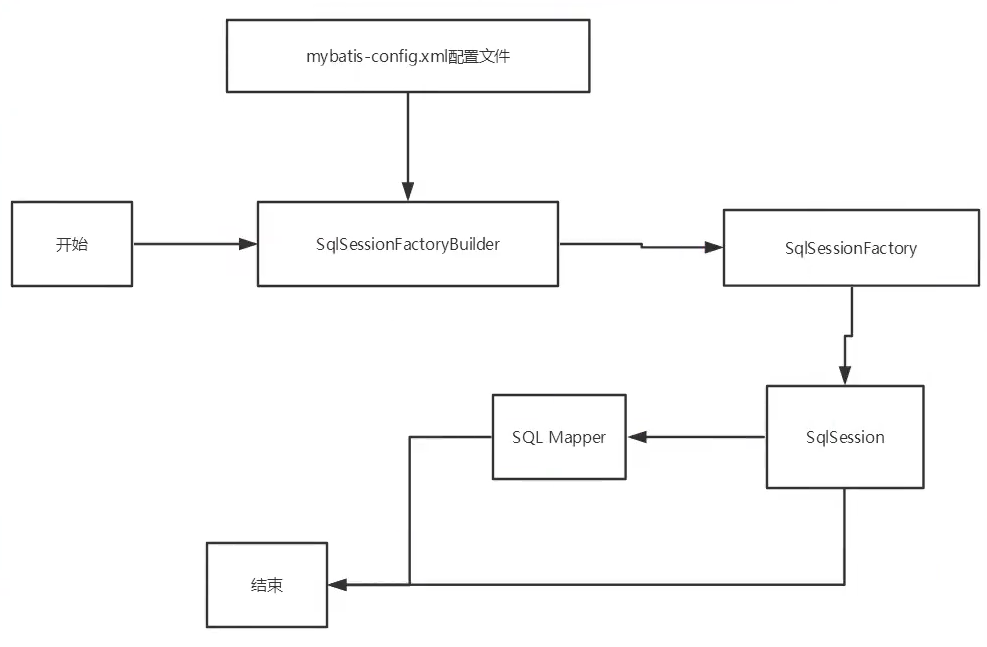
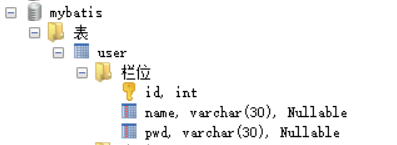

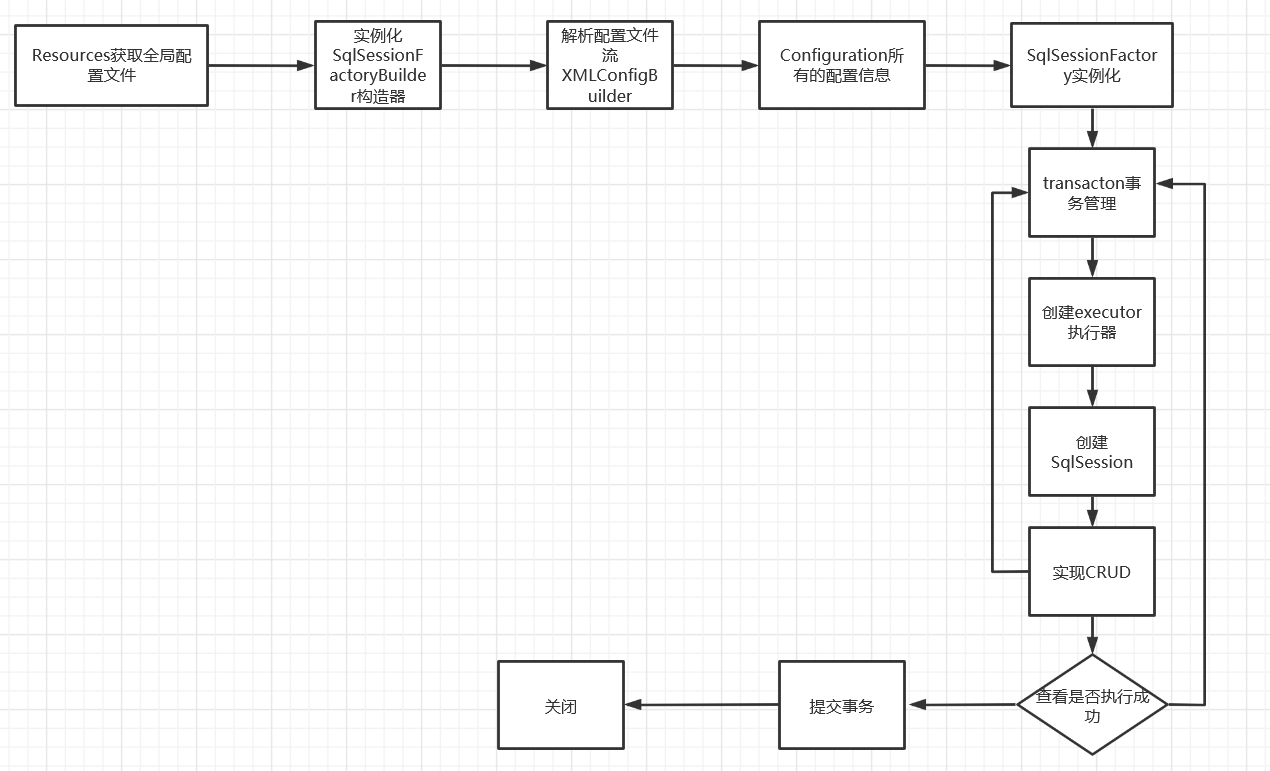

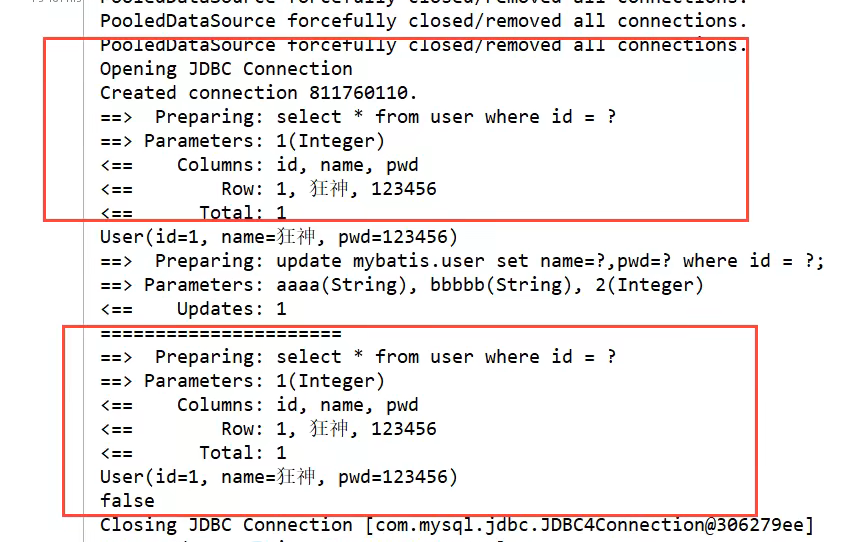

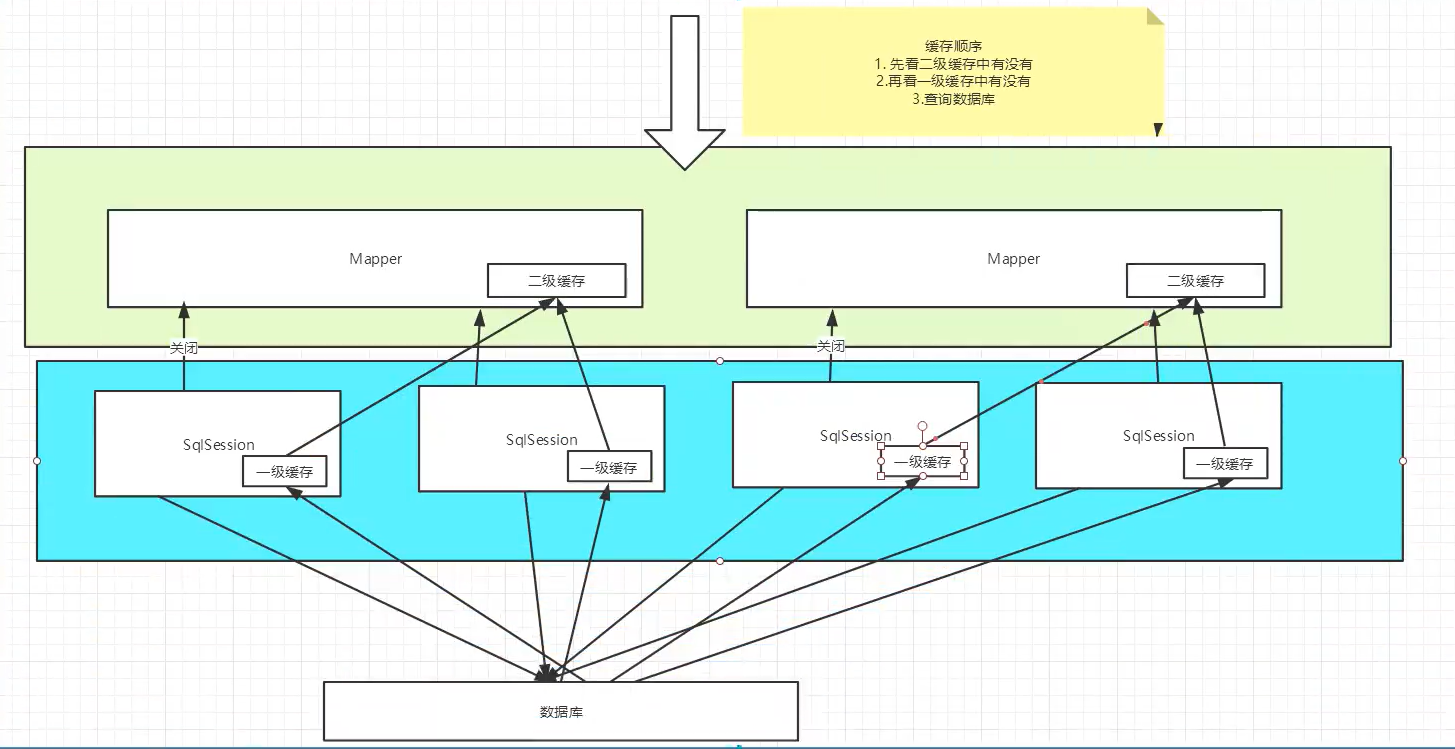



【推荐】国内首个AI IDE,深度理解中文开发场景,立即下载体验Trae
【推荐】编程新体验,更懂你的AI,立即体验豆包MarsCode编程助手
【推荐】抖音旗下AI助手豆包,你的智能百科全书,全免费不限次数
【推荐】轻量又高性能的 SSH 工具 IShell:AI 加持,快人一步
· 开源Multi-agent AI智能体框架aevatar.ai,欢迎大家贡献代码
· Manus重磅发布:全球首款通用AI代理技术深度解析与实战指南
· 被坑几百块钱后,我竟然真的恢复了删除的微信聊天记录!
· 没有Manus邀请码?试试免邀请码的MGX或者开源的OpenManus吧
· 园子的第一款AI主题卫衣上架——"HELLO! HOW CAN I ASSIST YOU TODAY